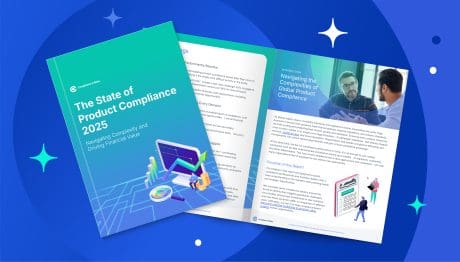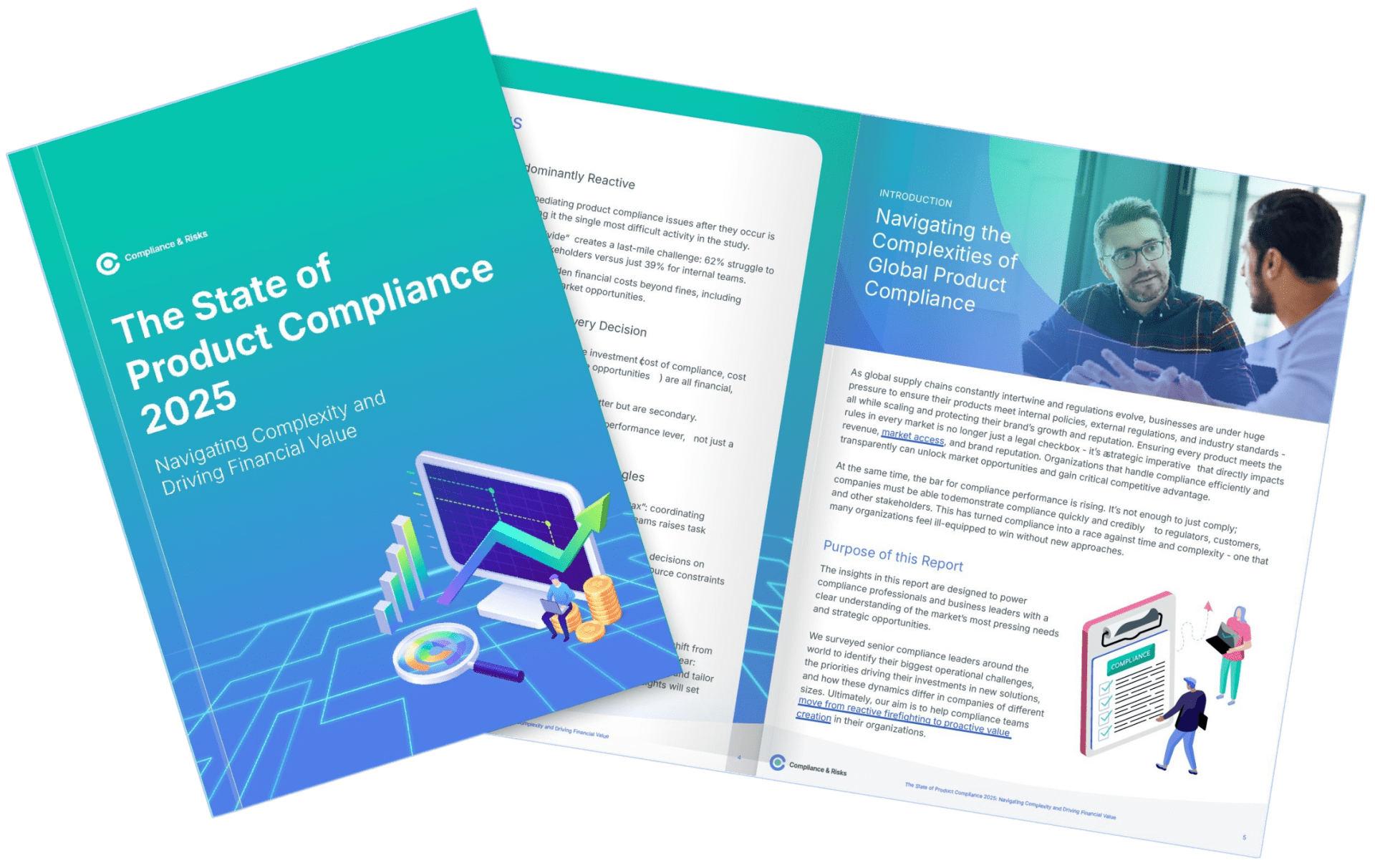
From Cost Center to Profit Driver: The Strategic Roadmap for Compliance Transformation

THIS BLOG WAS WRITTEN BY THE COMPLIANCE & RISKS MARKETING TEAM TO INFORM AND ENGAGE. HOWEVER, COMPLEX REGULATORY QUESTIONS REQUIRE SPECIALIST KNOWLEDGE. TO GET ACCURATE, EXPERT ANSWERS, PLEASE CLICK “ASK AN EXPERT.”
The mandate for product compliance has changed. It’s no longer enough to “pass the audit.” In 2025, executives expect compliance to protect revenue, open markets, and deliver reliable savings – not just mitigate risk. Our State of Product Compliance 2025 research shows why: the four most-cited investment metrics are all financial, complexity rises sharply with scale, and persistent evidence gaps block launches and lengthen audits. The organizations winning today have reframed compliance as a growth enabler with a clear, finance-grade compliance strategy roadmap.
This forward-looking guide synthesizes the transformation themes from the report into a practical blueprint you can start deploying this quarter.
Table of Contents
- Why Compliance Must Become a Profit Driver
- The Transformation Blueprint: A Four-Stage Roadmap
- Right-Sizing the Roadmap for Enterprise vs. Mid-Market
- Operating System: Metrics, Cadence, and Governance
- Quick Answers
- FAQs
- Download the Full Report
Why Compliance Must Become a Profit Driver
Three realities from the research set the agenda for compliance transformation:
- Financial outcomes dominate. Budgets are awarded to programs that reduce the cost of compliance and cost of violations, while protecting revenue at risk and creating revenue opportunities. Efficiency matters when it translates into dollars.
- Complexity increases with scale. Large enterprises face a measurable “complexity tax” – coordinating lifecycle coverage, external evidence, and cross-regional teams. Expertise isn’t the bottleneck; orchestration is.
- Evidence gaps are the last-mile bottleneck. Many teams can do the work but can’t prove it quickly to regulators and customers. That disconnect drives delays, escalations, and extra cost.
To turn compliance into competitive advantage, your roadmap must close the evidence gap, tame complexity, and express value in CFO-ready terms.
The Transformation Blueprint: A Four-Stage Roadmap
Stage 1: Establish Finance-Grade Baselines
Goal: Translate compliance activity into measurable P&L impact.
Moves
- Build a baseline in 30 days: total cost of compliance (labor, vendors, audits, translations, testing) and recent cost of violations by incident type.
- Tie products to markets with a rolling revenue at risk view (likelihood × impact) and note revenue opportunities from new launches or market entries.
- Socialize assumptions with Finance; lock the baseline so improvements are attributable.
Output
- One-page scorecard with the four financial metrics and a trendline.
- Shared definitions (taxonomy, naming, evidence list) so data sticks.
Stage 2: Productize Evidence and Control the Last Mile
Goal: Make evidence capture and packaging automatic and instant.
Moves
- Capture proofs at the point of work (design controls, supplier onboarding, lab results).
- Normalize metadata so packages can assemble by product/market/audit scope in clicks.
- Introduce SLAs: “evidence audit-ready within 48 hours,” measured weekly.
- Replace ad hoc folders with a structured evidence library mapped to each jurisdiction’s expectations.
Impact
- Immediate reduction in audit overage, consulting hours, and scramble time.
- Faster responses to customer and regulator requests; fewer escalations.
Metric lift
- Lower cost of compliance (steady-state OpEx)
- Lower cost of violations (fewer findings tied to documentation issues)
Stage 3: Shift Left and Industrialize Prevention
Goal: Reduce late-stage remediation by moving compliance upstream.
Moves
- Embed machine-readable market rules into design gates and supplier intake.
- Require suppliers to attest with proof templates aligned to target markets.
- Track “defects escaped to late stage” and “lifecycle coverage rate” by product and market.
- Run quarterly “design-to-proof” audits: does every control generate its evidence artifact?
Impact
- Fewer launch-blocking surprises; reduced rework and expedited testing.
- Predictable time-to-market and healthier program morale.
Metric lift
- Reduced cost of violations and revenue at risk
- When tied to release planning, improved revenue opportunities (earlier or expanded launches)
Stage 4: Monetize Compliance Advantage
Goal: Turn operational wins into market-facing value.
Moves
- Sequence launch calendars around compliance readiness to pull revenue forward in priority markets.
- Convert evidence strength (e.g., sustainability, safety) into deal enablers for RFx and preferred vendor lists.
- Publish customer-facing compliance assurances with verifiable, audit-ready claims.
- Partner with Sales to quantify win-rate lift where readiness or attestations play a role.
Impact
- Shorter sales cycles, differentiated brand trust, and entry into regulated or high-margin markets.
Metric lift
- Increased revenue opportunities and reduced revenue at risk
- Clear attribution from compliance milestones to commercial outcomes

The State of Product Compliance 2025: Navigating Complexity & Driving Financial Value
Fresh insights from 500 global compliance leaders – uncover the biggest challenges, priorities, and opportunities shaping compliance this year.
Right-Sizing the Roadmap for Enterprise vs. Mid-Market
$10B+ Enterprises: Orchestrate at Scale
- Prioritize integration across PLM/QMS/document control; eliminate evidence islands.
- Formalize RACI across engineering, quality, legal, regions; govern through lifecycle coverage and evidence readiness.
- Stand up a central evidence platform with product/market views and role-based access.
$500M–$1B Mid-Market: Decide Faster with Less Overhead
- Start with a finance-grade spreadsheet baseline and a lightweight evidence library.
- Implement decision intelligence: for each market change, model comply vs. defer vs. exit with revenue, cost, and timeline.
- Choose modular tools that deploy in weeks, not quarters; minimize admin burden.
Operating System: Metrics, Cadence, and Governance
Scorecard (quarterly trend)
- Cost of compliance (run rate and savings realized)
- Cost of violations (incidents avoided; dollars saved)
- Revenue at risk (mitigated exposure)
- Revenue opportunities (captured via earlier launches or market entries)
Operating cadence
- Weekly: evidence readiness by product/market, exceptions, and SLAs.
- Monthly: lifecycle coverage rate, defects escaped to late stage, supplier proof conformance.
- Quarterly: portfolio-level revenue at risk and opportunity review tied to launch planning.
Decision rights
- Empower a cross-functional Compliance Transformation Council (product, engineering, quality, legal, finance, regional) to resolve bottlenecks and approve investments with documented P&L impact.
Quick Answers
What is a compliance transformation roadmap? A staged plan that turns compliance from audit pass/fail into a system that reduces cost, prevents violations, and protects or creates revenue – measured in CFO-ready terms.
Where should we start? With a finance-grade baseline and evidence productization. These yield rapid savings and create the foundation to shift left.
How does this create competitive advantage? Provable, on-demand evidence builds customer trust; earlier, predictable launches drive first-mover revenue; fewer violations and rush fees improve margins.
How do we handle enterprise complexity? Integrate systems, normalize data, and govern through lifecycle coverage and evidence readiness – coordination is the constraint to solve.
What about mid-market teams with lean resources? Adopt decision intelligence and lightweight tooling. Prove ROI with clear deltas in cost, avoided incidents, and revenue pull-forward.
FAQs
- Isn’t this just an IT project? No. Technology enables the model, but value comes from process design (capture proof in-flow), governance (clear ownership), and finance discipline (attribution to P&L).
- How fast can we show results? Evidence productization typically reduces audit coverage and consulting support within one quarter, freeing capacity to shift left on design and suppliers.
- How do we avoid over-claiming revenue impact? Use conservative attribution: only claim the portion of acceleration or win-rate clearly tied to compliance readiness and evidence strength; publish sensitivity ranges.
- What KPIs matter most to the board? Lead with the four: cost of compliance, cost of violations, revenue at risk, revenue opportunities. Tie cycle-time and operational metrics directly to these outcomes.
Download the Full Report
If you’re ready to move beyond audit survival and make compliance a growth engine, the State of Product Compliance 2025 provides the benchmarks, maturity signals, and templates to accelerate every stage of your roadmap.
Download the complete State of Product Compliance 2025 report to turn compliance from a cost center into a profit driver.


